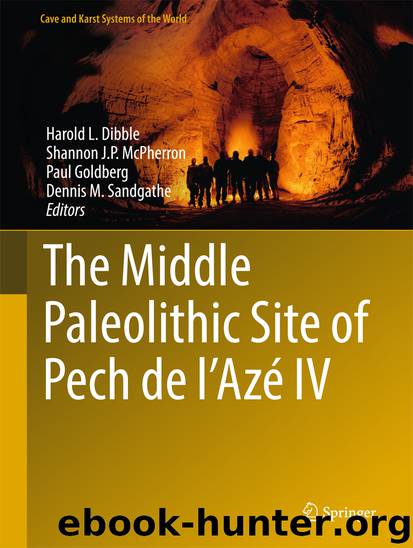The Middle Paleolithic Site of Pech de l'Azé IV by Harold L. Dibble Shannon J. P. McPherron Paul Goldberg & Dennis M. Sandgathe

Author:Harold L. Dibble, Shannon J. P. McPherron, Paul Goldberg & Dennis M. Sandgathe
Language: eng
Format: epub
Publisher: Springer International Publishing, Cham
Taphonomic Analysis of Nutrient Extraction Behaviors
One of the most important taphonomic analyses run at the site was to establish the frequency of skeletal elements that were intentionally broken for the extraction of nutrients (by Neanderthals or carnivores) versus the number of elements unintentionally broken by processes such as trampling, roof collapse, etc. The purpose of this analysis was to evaluate the extent to which hominins and carnivores extracted nutrients from skeletal elements at the site and to evaluate the role that post-depositional processes played in the formation of the assemblage. This analysis was conducted following methods outlined by Villa and Mahieu (1991) who established criteria for determining if long bones had been broken in a fresh state, in which internal bone nutrients such as bone marrow and grease were still present in the element, versus if a long bone was broken in a dry state when nutrients were no longer preserved. Experimental studies of breakage patterns caused by hominins and carnivores (Marean et al. 2000) can now be used to calibrate data generated by bone breakage analyses allowing them to be more effectively applied to zooarchaeological remains. For example, based on actualistic experiments in which skeletal elements were broken for the express purpose of marrow extraction, the expected frequency of elements with fresh-bone breaks is 85 ± 3% (Blumenschine 1988; Capaldo 1995, 1998; Marean et al. 2000). It should be noted that data from the experimental assemblages listed here as “carnivore only”, “hominid to carnivore”, and “hominid only” represent the limits of a range of variation that exists for the accumulating processes for large mammals in caves. Within the experimental data comparisons “carnivore only” includes experiments in which carnivores were fully responsible for breaking bones, “hominid only” refers to experiments for which Neanderthals were fully responsible for breaking bones, and “hominid to carnivore” is a situation where Neanderthals broke the bones first and then carnivores later fed on them.
Download
This site does not store any files on its server. We only index and link to content provided by other sites. Please contact the content providers to delete copyright contents if any and email us, we'll remove relevant links or contents immediately.
| Africa | Americas |
| Arctic & Antarctica | Asia |
| Australia & Oceania | Europe |
| Middle East | Russia |
| United States | World |
| Ancient Civilizations | Military |
| Historical Study & Educational Resources |
Underground: A Human History of the Worlds Beneath Our Feet by Will Hunt(12022)
Sapiens by Yuval Noah Harari(5293)
Navigation and Map Reading by K Andrew(5111)
The Sympathizer by Viet Thanh Nguyen(4305)
Barron's AP Biology by Goldberg M.S. Deborah T(4096)
5 Steps to a 5 AP U.S. History, 2010-2011 Edition (5 Steps to a 5 on the Advanced Placement Examinations Series) by Armstrong Stephen(3687)
Three Women by Lisa Taddeo(3353)
Water by Ian Miller(3126)
The Comedians: Drunks, Thieves, Scoundrels, and the History of American Comedy by Nesteroff Kliph(3039)
Drugs Unlimited by Mike Power(2545)
A Short History of Drunkenness by Forsyth Mark(2233)
DarkMarket by Misha Glenny(2158)
The House of Government by Slezkine Yuri(2158)
And the Band Played On by Randy Shilts(2127)
The Library Book by Susan Orlean(2041)
Revived (Cat Patrick) by Cat Patrick(1963)
The Woman Who Smashed Codes by Jason Fagone(1929)
Birth by Tina Cassidy(1864)
The Absolutely True Diary of a Part-Time Indian by Sherman Alexie(1856)
